These four hit songs are perfect for your at-home power yoga routine
These four songs are the perfect additions to your power yoga playlist. Power yoga is an intense, fitness-based version of vinyasa yoga, a form of the practice known for its seamless flow from one pose to the next. Music can play an important role in getting you in the right mindset for a yoga workout, according to certified yoga instructor Karen Kassover.
“If you play a very strong song, the poses become stronger. If you play a relaxing song at the end, it helps you relax. The music really helps the practice,” Kassover told Shape.
Spanish singer Rosalia’s “Di mi nombre,” is an alt-flamenco pop hit which peaked at No. 1 on Spain’s music charts. The song is medium tempo while simultaneously upbeat. This is a great combination for power yoga, which flows quicker than traditional forms with yogis transitioning from each pose in just a few breathes.
Next up, Lana Del Rey’s cover of Sublime’s 1996 song “Doin’ Time” will give your routine those airy, California vibes and what Pitchfork describes as “roiling trip-hop percussion.” While power yoga is known more for its strength training than its meditative properties, Lana Del Rey’s breathy coos will remind you to inhale and exhale every once in a while.
Let Tame Impala’s “One More Year” up the intensity. The psychedelic funk song and opening track of the artist’s fourth record “The Slow Rush” will up the ante with its thumping drums. But fear not, singer Kevin Parker’s gentle voice won’t overpower your ears or distract you from the energizing workout.
Finally, slow things down with Chet Faker’s 2014 single “Talk is Cheap.” The soulful, alternative R&B song will help transition into a cool down while providing a melodic close out to your power yoga routine.
With most gyms closed, a great power yoga workout with the perfect playlist might be a worthy venture.
If you enjoyed this story, you may also like reading about these free yoga YouTube channels for every type of yogi.
Story continues
More from In The Know:
A definitive ranking of the Bon Appétit test kitchen hosts
You can still buy the $5 cleanser Marilyn Monroe and Jackie Kennedy used
This $20 tightening cream feels like ‘vacation in a jar’
Shoppers love this $6 balm that treats damaged hair
02

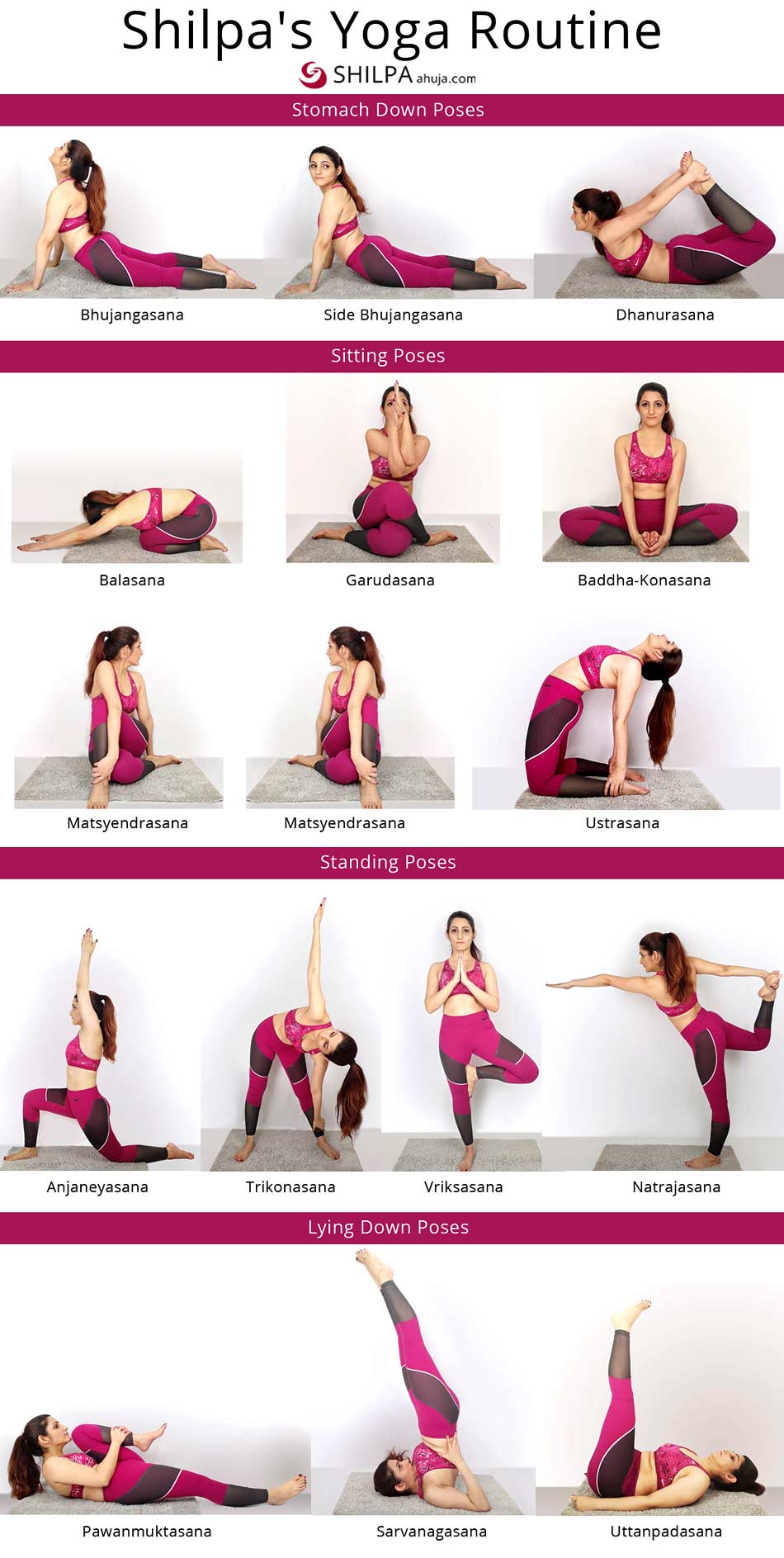 Shilpa’s Yoga Routine
Shilpa’s Yoga Routine

 2. Side Bhujangasana
2. Side Bhujangasana
 3. Dhanurasana or Bow Pose
3. Dhanurasana or Bow Pose
 Sitting Poses
Sitting Poses
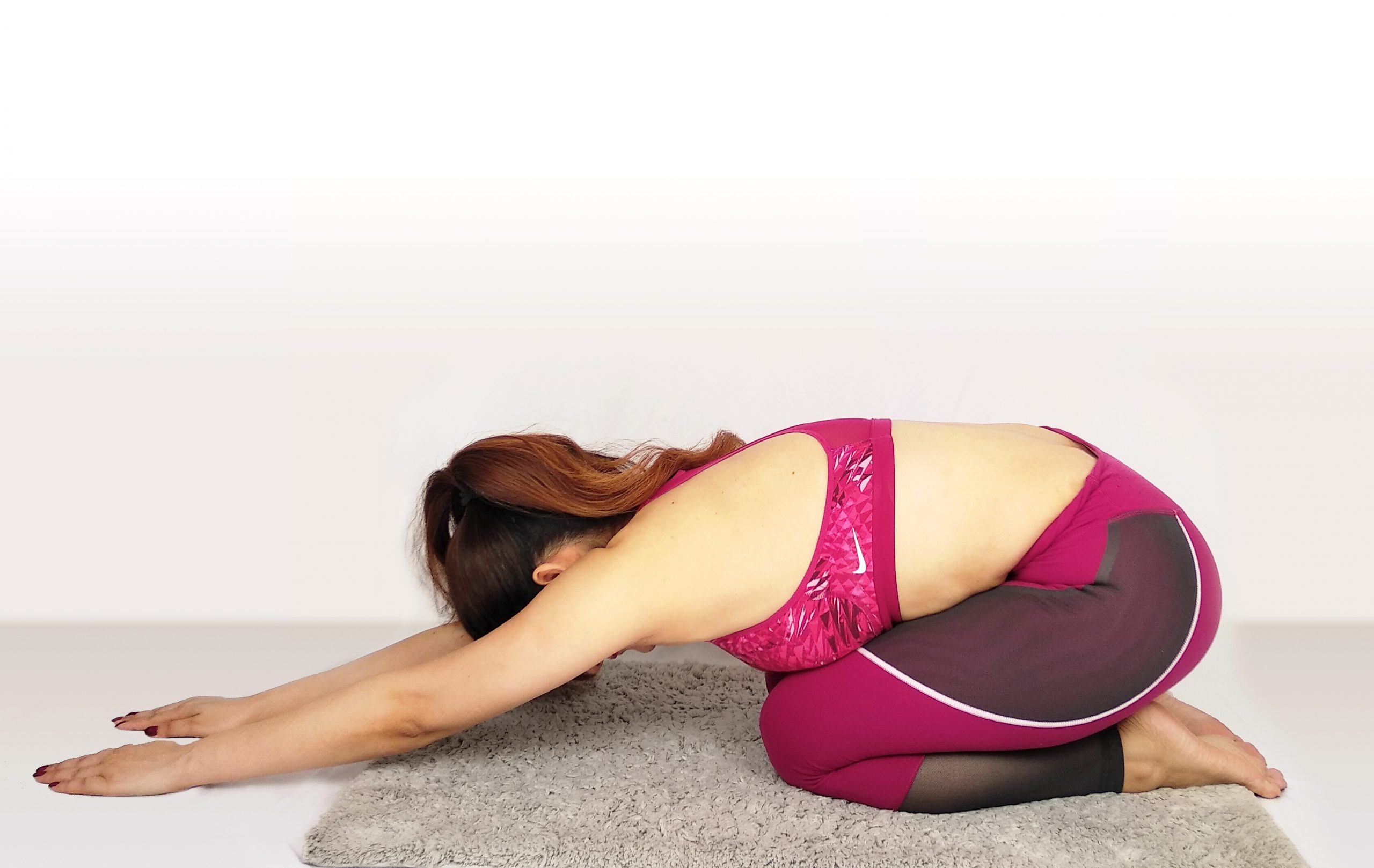 5. Garudasana or Eagle Pose
5. Garudasana or Eagle Pose
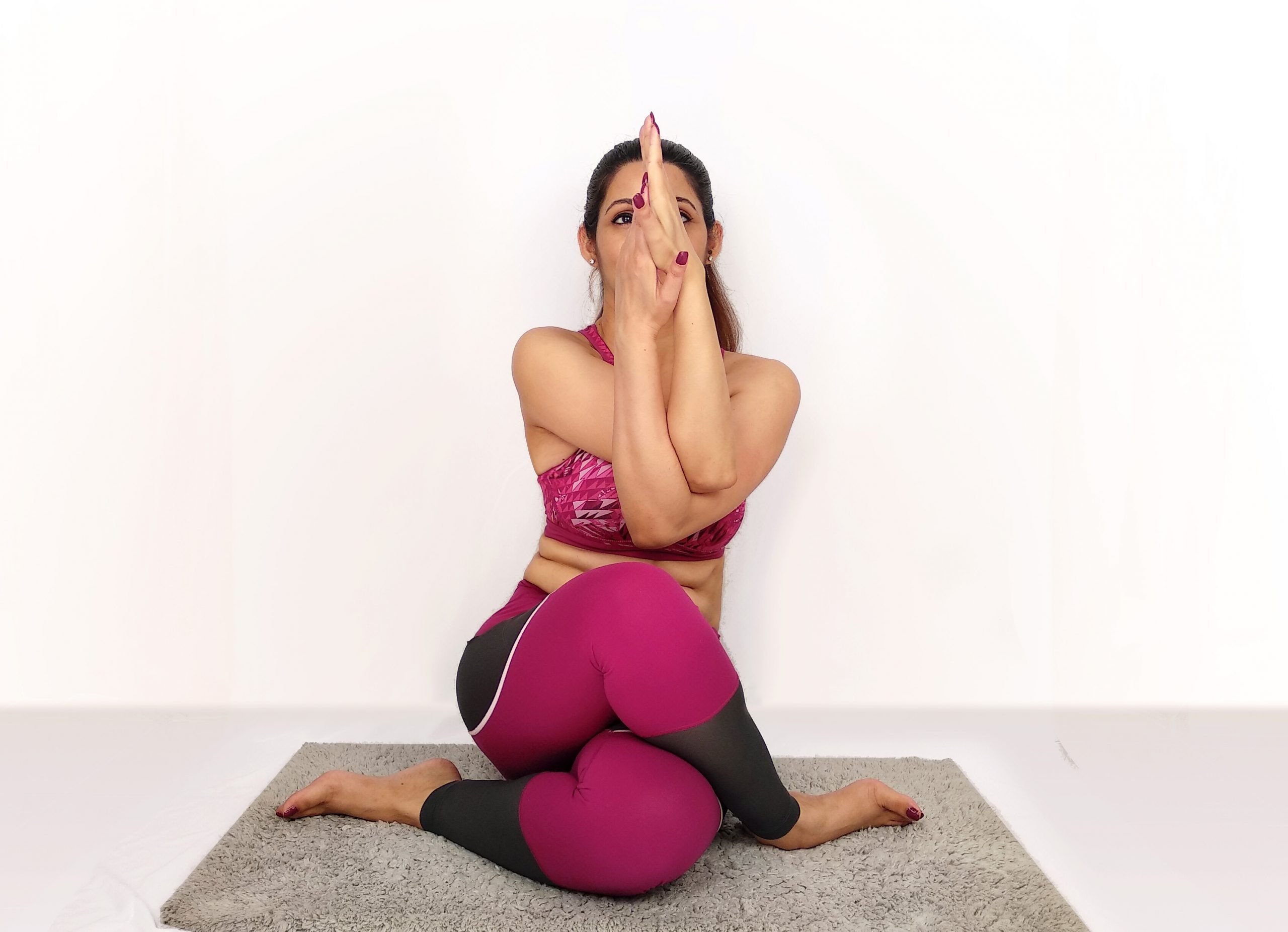 6. Baddha-Konasana or the Bound Angle Pose
6. Baddha-Konasana or the Bound Angle Pose
 7. Matsyendrasana or Lord of the Fishes Pose
7. Matsyendrasana or Lord of the Fishes Pose
 8. Ustrasana or Camel Pose
8. Ustrasana or Camel Pose
 Standing Poses
Standing Poses
 10. Trikonasana or Triangle Pose
10. Trikonasana or Triangle Pose
 11. Vriksasana (Vrikshasana) or Tree Pose
11. Vriksasana (Vrikshasana) or Tree Pose
 Lying Down Poses
Lying Down Poses
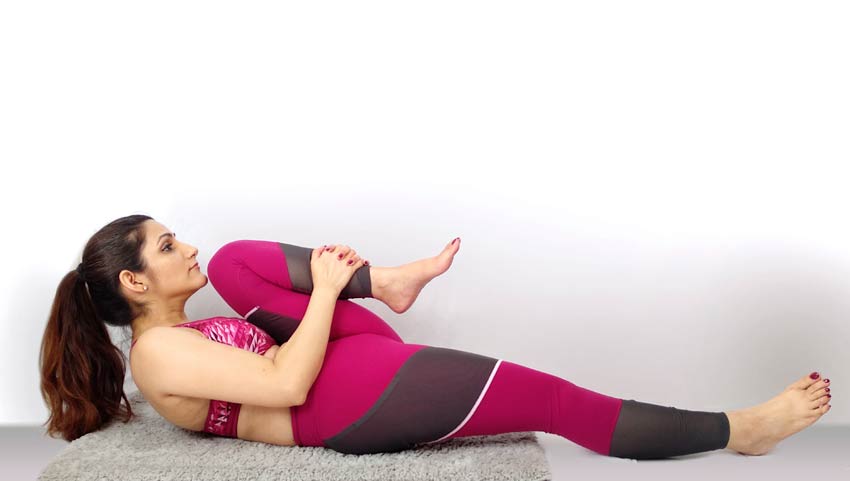 14. Sarvanagasana or Shoulderstand
14. Sarvanagasana or Shoulderstand
 15. Uttanpadasana or the Raised Leg Pose
15. Uttanpadasana or the Raised Leg Pose
 Pranayama
Pranayama
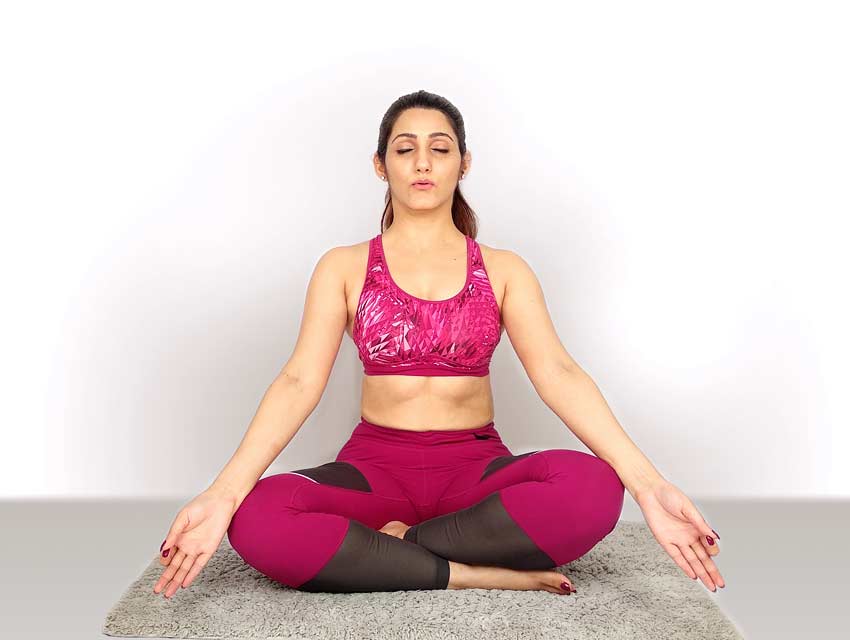 6. Meditation
6. Meditation
Shilpa’s Yoga Routine & Basic Yoga Poses Chart
Share
Share
Share
Email
Improve your overall health and feel productive all day; yoga is essential to create a fitness routine during lockdown. Here is the COMPLETE guide to my yoga routine and poses for beginners.

As the Coronavirus pandemic is slowly taking over the world, it’s also making us appreciate the basics like healthy, traditional home-cooked food and simple, at-home ways to improve our fitness. For me and my husband, yoga routine became an important part of our daily lives even before the pandemic became global.
Benefits of Yoga
Yoga is rooted in Indian history and it is how people maintained their health for hundreds of years before hospitals even existed. The yogis mastered the art of yoga, and became able to maintain poses for hours at a stretch, and as our history tells it – even days. Mostly, people only know about how yoga improves our body’s flexibility. Essentially, a yoga routine is believed to enable us to live longer, on lesser food and maintain better respiratory and cardiovascular systems.
Unlike the gym, yoga doesn’t focus on the aesthetic fitness, but instead on holistic health. It may not help you with immediate weight loss or abs, but its benefits include improving our overall wellness. Yoga also improves mental health, reducing stress and anxiety. It lowers our blood pressure and improves our longevity. It’s also a great workout for those who hate cardio, for older people, pregnant women and those who have back or joint issues.
Personally, I always loved faster, heavier workouts like running, Zumba, badminton, squash or tennis, and until last year I used to find yoga boring! I learned it in college as a part of our physical education class. But I had forgotten how good I was at it until early this year, when my husband got me back into it.
In early January this year, we started doing it every morning, first for 20 minutes everyday, then increased it to 50 minutes daily, as I began to recall more poses and started enjoying it! Honestly, it’s one of the few types of exercises I’ve been able to do regularly, making it a part of my daily lifestyle. I don’t find excuses to miss it, in fact, I love waking up early just to do yoga and it makes me start my day on a calm, peaceful note.
So as we all find ways to improve our immunity during the Coronavirus pandemic, I’d like to share my personal yoga routine with you all, hoping it can give you the same health benefits it’s given me, and help you fight the disease.
How to do Yoga
Yoga should be ideally done on a yoga mat placed on the floor. Or you can also use any other mat that’s neither too soft nor too hard. Find an open space to do it, like your living room. The space should ideally have cross-ventilation and you can open your windows. Do it at normal, comfortable room temperature that’s neither cold, nor makes you sweat.
Frequency
It’s best to do yoga daily. If you have other fitness goals like weight loss or abs, I’d recommend doing it every alternate day and fitting in cardio or dumbbell workouts on your other days. If you’re just getting started, try to do yoga every day, or at least 4-5 times a week.
When to do Yoga
Yoga should be done on an empty stomach, so it’s best to do it in the morning.
Duration
To begin with, try the simple asanas (poses) and combine yoga with pranayama. Your sessions can be 20 minutes long. As you include more and harder asanas, you can increase your yoga routine duration to an hour or 50 minutes, depending on your lifestyle.
What to Wear
The ideal yoga attire is something that lets you stretch your body comfortably. A t-shirt and leggings or stretchable pajamas can be a good idea. You can also wear a sports bra. Your clothes should never be too tight, as they’ll not let you stretch properly. Nor should they be too loose, otherwise they’ll keep riding up during some of the asanas. I simply wear a tank top and a pair of shorts for my yoga sessions, as Chennai is an extremely hot place to wear leggings!

Note: If you suffer from any physical problems, injuries or are pregnant, please consult your doctor to know which poses you should avoid. If you’re generally fit, you should do each pose just until your body allows. Beginners should avoid over-stretching their body. The thumb-rule to follow is that your body should not hurt anywhere after your yoga session. The yoga routine should leave you relaxed, not in pain.
Let’s start with a bit of pranayama.
Before you Start your Yoga Session
Before I start my yoga routine, I sit cross legged (sukhasana), eyes closed and meditate for a couple of minutes. This helps me remove all negative thoughts, relieve anger and enables me to focus on the upcoming asanas.

Once you’re done, it’s best to improve your breathing with kapalbhati. For this, sit cross-legged or in sukhasana, or whatever you’re comfortable in. Now force your breath out in quick intervals repeatedly. You don’t have to hold your breath for this, the idea is to inhale very quickly before each exhalation. Try to do 20-30 breath pumps in the beginning, and then try to go up to 200 over the next month.
Stomach Down Poses
I’ve divided my daily yoga routine into 4 parts. The first is a set of stomach down poses, which are beneficial for your spine and also work your upper abs. Maintain each of these poses for 30 seconds. Between each pose, rest for 20-30 seconds. For the resting position, lie flat on your stomach, arms folded to support your face.
1. Bhujangasana or Cobra Pose
This is the best one to start with and is very effective in strengthening your back. This pose stretches your chest and helps open up your lungs. Your legs should be a foot apart, feet facing down. Curl your upper body to face the ceiling and keep your arms either bent or straight. Hold for 30 seconds and then rest for another 30.

In this repetition, do the same Cobra pose, but turn your head to one side, and try to look as far towards the back, to the other side, as possible. Hold for 30 seconds, and then move onto the other side, after resting for 30 seconds.

This is a great pose for strengthening your back, stomach and thighs. This is also one of the most effective poses in this yoga routine. Lie on your stomach, then bend your knees and if you can, try to hold your feet with your arms. Keep your chin up, looking up front.

The next set is of sitting poses, which are beneficial for your thighs and upper body. Once again, maintain these poses for 30 seconds each. And rest for 20-30 seconds between each pose. For the resting position, sit cross-legged or in padmasana. If you have back problems, you can sit against a wall or lie down between each pose.
4. Balasana or Child’s Pose
Sit with your legs folded, back straight and your hips resting on your feet, without any gap between your legs. This is called the kneeling pose or Vajrasana. Now stretch your arms straight upwards. Then slowly, take them forward, touching the ground in front of you. Your head should not touch the ground and your neck should not bend.

Bend one of your knees, then stack the other knee right above it, your feet on either side. If this is too difficult, do this pose in the lotus position (padmasana). Your back should be straight. Now cross and bend your elbows, and try to do namaste. If you have stiff shoulders, it’ll take a few weeks to master this.

One of my favorite asanas, this one is great for relieving stress in your thighs. Bend your knees and cup your hands around your feet. Then bring your feet towards you, facing and touching each other. Your back and head should be straight, looking to the front.

This is another one that may take a couple of weeks to master. Simply bend your left knee and place its foot next to the right hip. Then fold your right leg to cross it. Place your right foot in front of the left knee. Now with your left hand, cup your right ankle in a way that it crosses your right knee. Keep your right arm straight and place your right palm, face down, behind your right hip. Now turn your head and shoulders towards the right, and look as far towards the back as possible. Don’t hunch – keep your back straight. Hold for 30 seconds and then rest in sukhasana for another 20-30 seconds. Then repeat on the other side.
I know it’s very confusing for beginners.
 8. Ustrasana or Camel Pose
8. Ustrasana or Camel Pose
This is one of my least favorite yoga poses because it’s so hard to do! My husband skips it completely!
Anyway, sit with your knees kneeled (Vajrasana). Then lift your hips and arch your back, resting your arms on your ankles. Cup your hands on your ankles and tilt your head to look straight up above. Try to stack your hips above your knees and your shoulders right above your feet.

Now we come to the set of standing poses, which are beneficial for your overall body, specifically knees, back and calves. Once again, these poses should be maintained for 30 seconds each. And rest for 20-30 seconds between each pose. For the resting position, just stand with your back straight and shoulders relaxed. If you have back problems, you can sit on a chair between each pose.
9. Anjaneyasana or Crescent Moon Pose
For this pose, keep your upper body straight, and step forward with one leg. Lower your hips until your other knee is touching the ground. Your front knee should be bent at 90 degrees angle. This is called a low lunge. Now keep the other foot straight on the ground, facing up. Keeping your back straight and your chest stretched, extend your arms from your sides, palms up, and slowly bring them in a namaste, all the way above your head. Look straight ahead with your chin up.

This is really easy to do. Simply stand with your legs apart (not too far apart). Then bend to one side, bringing your left hand to hold your left ankle. Look straight up above, and extend your right arm straight above your shoulder. Maintain for 30 seconds, then repeat on the other side.

This is one of my favorite poses. It requires a bit of practice, but once you master it, you won’t want to stop!
Stand with your back straight, chin up, looking straight ahead. Now bend your right knee, bringing your right foot to rest on the side of your left thigh. Stretch your right thigh, so that both your knees are in the same plane. To balance your body, fold your hands in a namaste. Once you master this pose, you can also try it with your arms stretched straight above your head.

Now the other side.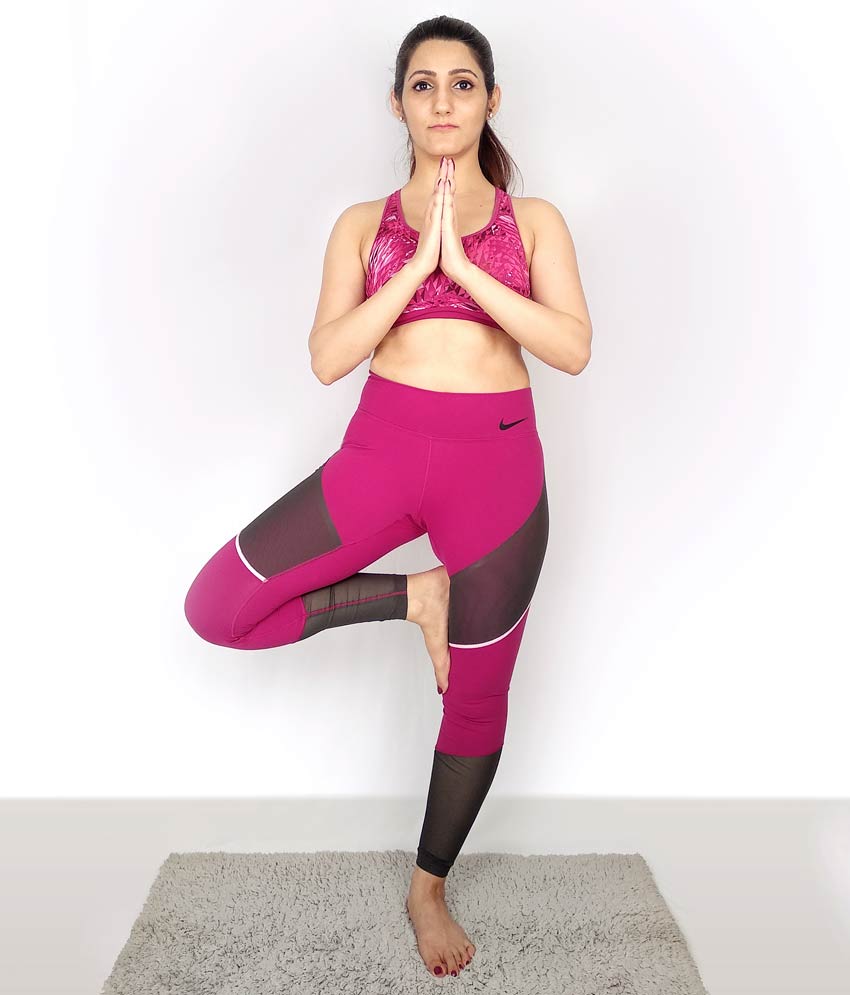
12. Natrajasana or Dancer Pose
I like this pose but it’s still hard for me to maintain my balance, even after all these years. For this pose, stand straight, and bend your right knee, taking your foot behind. Then, while extending your right arm to hold your right foot, stretch your left arm straight ahead in front of you. Both your arms should be forming a straight line parallel to the ground. Try to stretch your right thigh, so that your right foot can extend as high as possible. Maintain for 30 seconds, then move on to the other side.

Now we come to the set of lying down poses, which are beneficial for your thighs, back and stomach. These poses will also help you reduce belly fat. Once again, maintain each pose for 30 seconds. And between each pose, rest for 20-30 seconds. For the resting position, just lie down with your ams straight, palms facing up (shavasana).
13. Pawanmuktasana or Gas Release Pose
Funny name, but it’s actually beneficial for your gut health as the name suggests! For this pose, lie down, then fold your right leg so that your thigh touches your chest. Now raise your head and bring your chin forward, touching the right knee. Try to keep your left leg straight on the ground. Hold for 30 seconds, then repeat for the other side. You can also do with both legs together.

This is my all-time favorite yoga pose! While you’re lying down, bend your knees slightly, and then raise your legs. Now, holding your waist with your hands, raise your hips and slowly, try to stretch your legs up above you. Try to raise your hips as much as possible, making a straight line with your body, and stretch your toes out, too.
I know it looks difficult for beginners, but if I can do it, you can do it, too! But be careful while lowering your body after you’re done. Try to bend your knees again, and slowly lower your hips until they touch the ground. Sudden motions can injure your back.

Now we’ve reached the last pose before we move on to pranayama. While lying down, place your arms next to your hips. Then simply raise your legs above you, so that they are straight and perpendicular to your body.

Great, now that all your poses are done, let’s move on to the last part of our yoga routine – pranayama. This is a set of breathing exercises that will improve your respiratory system and help relax your body. By the way, if you suffer from stress or anger issues, it’ll help with that, too. It also lowers your blood pressure and helps keep your body in an overall good condition. All in all, it’ll also help strengthen your body to fight the Coronavirus that directly attacks the throat and lungs.
Also read: A Beginner’s Guide to Prana Yoga & its Benefits
1. Deep Breathing
Sit cross-legged in sukhasana, with your back straight and shoulders relaxed and hands resting on your knees. Now breathe slowly, take more time exhaling than inhaling. Do this for 30 breath pumps. This will relax your muscles and improve your concentration, which will help with the following exercises.
2. Kapalbhati
We’ve already done a few breathing pumps. But now that we’ve done physical exercises, our body will be more capable of doing kapalbhati. Force your breath out in quick intervals repeatedly. Try to do 30-50 breath pumps, while exhaling quickly and inhaling even more quickly.
3. Anulom Vilom (Alternate Nostril Breathing)
This one is great for improving lung-functioning, cleansing the respiratory tract and asthma problems.
Keeping your hand straight, close the left nostril with your left thumb and inhale slowly. Now hold for a few seconds, letting the air fill up your lungs. Then, close your right nostril with your other finger and exhale slowly from the left nostril. Repeat 15 times, and then move on to the other side, other hand.
4. Kumbhaka or Breath Retention
Now for this, first inhale slowly, letting the air completely fill up your lungs. Now hold your breath for 30 seconds. Then exhale. Repeat thrice, taking a few seconds break between each repetition.
Then, first exhale slowly, emptying your lungs completely. Again, hold your breath for 30 seconds and then inhale slowly. Repeat thrice.
For yoga routine beginners, if you’re finding it difficult to hold your breath for 30 seconds, just try to hold it for 15 seconds or as long as you can, and with practice, you’ll be able to go on to 30 seconds or even a minute. This exercise increases the longevity of our lungs.
5. Om Yoga
Om yoga is the practice of slowly chanting om, out loud and stressing on each syllable. This is a meditation technique, and it helps improve your mental health, concentration, immunity and heart health.
Om is the sound of the universe, according to Hinduism. The word ‘Om’ consists of three syllables – A, U and M, and a silent syllable, which if chanted slowly, are believed to increase our internal energy.
So take a deep breath and chant the word ‘Om’ , extending out each syllable. The longer you extend each part of the sound, the longer it’ll help you extend your exhalation, improving your concentration. Try to say each syllable A, U and M for 5 or 6 counts. With practice, you’ll be able to extend it further.

Let’s end our yoga routine with a couple minutes of meditation. To meditate, sit in sukhasana with your eyes closed. Simply breathe normally for a few seconds, then breathe slowly, taking longer to exhale than to inhale. Concentrate on each breath and empty your mind of any other thoughts than that of the breath itself.
Continue for a couple of minutes. Then slowly bring your mind to concentrate on external sounds, keeping your eyes closed. Try to hear the sounds of birds or other noises, try to place their direction. Finally, slowly open your eyes and you’re done!
It helps restore energy and improves blood flow. Overall, it’ll bring your body in a general Zen mode and help you deal with your day’s tasks with improved concentration and healthy mental state.
Hope you found this yoga routine and poses guide helpful. Share your comments below and share your yoga pics by tagging me on Instagram @shilpaahujadotcom! Stay healthy!
Read next:
https://shilpaahuja.com/how-to-prepare-for-coronavirus-the-athletes-advice/
https://shilpaahuja.com/get-fit-basic-home-exercises/
Shilpa Ahuja a designer and entrepreneur. She is the editor-in-chief of ShilpaAhuja.com, which she founded with the goal of inspiring confidence in the modern working woman through fashion.
Fashion has traditionally been for the rich, white, thin woman. That’s how it evolved over centuries and that’s how it’s been represented in fashion media. But Shilpa believes that with the changing role of women in the society, fashion has changed, too. She believes that fashion is for everyone, regardless of their age, gender, color, body type and background. So she translates runway fashion into easy style advice that one can incorporate into their daily lives.
Shilpa’s work has been published in the University of Fashion blog and Jet Airways magazine. She is also an artist, illustrator and cartoonist. She is also the creator of Audrey O., a comic series that represents the lifestyle of millennial women. She enjoys creative writing and world travel. Her art has been exhibited at Harvard Graduate School of Design and the Aroma Hotel, Chandigarh and been published in Chandigarh Times.
Originally from Chandigarh, Shilpa also has a professional degree in architecture and has worked in interior project management. She is also the author of the book “Designing a Chinese Cultural Center in India”. Shilpa has a Masters in Design Studies degree from Harvard University. For feedback and questions, please email [email protected]
basic yoga, different types of yoga, om yoga, yoga, yoga advice, yoga benefits, yoga fitness, yoga for beginners, yoga poses, yoga routine, yoga sequence
03
7 minute yoga to stay calm at home
Yoga is incredible. It helps fight symptoms of depression and stress from overworking. This ancient practice might help you stay well during staying at home during the coronavirus pandemic. Yoga has been shown to have many therapeutic effects from physical to spiritual pain relief. Doing a few minutes of yoga in the middle of your day might even become a permanent routine after it all among other healthy habits.
Staying at home juggling video calls, kids or anything else can be stressful. Here’s a 7-minute yoga routine from Rachel Sherman, a certified yoga instructor in New York City that has been leading small sessions over breaks on Zoom calls during COVID-19. She has routines for every moment at home.
For when you’re feeling sluggish or disconnected from your body: Breath of Joy
Stand with feet a little wider than hip-width apart
Root into all four corners of the feet and find a long spine
Inhale through the nose, take arms up overhead
Exhale through the nose, take arms down by your side
Repeat once, then inhale through the nose and take arms up but on the exhale, bend the knees slightly and fold forward over legs, exhaling through the mouth to create a “HA” sound
Keep repeating the three-step motion, increasing the pace, and lifting the arms up and down more rapidly
After about a minute, take a round at a slow pace
Stand upright and place one hand on the belly, one hand on the heart
Close the eyes
Notice if anything has shifted, feel your heart rate start to slow, find stillness and feel connected to your physical body
For low back pain from sitting all-day
Take a few rounds of cat and cow
Come to hands and knees, hands directly under shoulders, knees under hips
Find a neutral spine and press the tops of the feet into your mat
Inhale as you drop the belly, heart and chin lift (cow)
Exhale as you round the back, dome the belly and pull the navel into the spine
Repeat at your own pace, try to be conscientious of your shoulders, don’t rest into the sockets, firmly press the mat away
After at least six rounds, find a neutral spine and walk the hands out in front of you for puppy dog pose
The knees stay under the hips at a 90-degree angle, only your palms walk forward, elbows extended, drop the head
It should look like a dog stretching!
Breathe here, taking a few moments to let the pose activate the space between your shoulder blades
When you’re ready, sit back on your heels, take the knees out wide, toes touch, and fold forward for a wide-leg child’s pose
Take a few breaths here, with each inhale reach forward, with each exhale sink a little deeper back onto the hips
Finally, come to hands and knees and roll yourself up to stand, unraveling vertebrae by vertebrae
Shrug the shoulders when you come to stand, inhale shoulders up to ears, exhale roll them down the back, repeat twice
Take feet directly below your hips and inhale arms up over head
Exhale as you bend at the knees and fold forward over your legs
Keep your knees bent as you grab opposite elbows and find a slight sway motion
Nod your head yes and shake your head no to release the neck
Gently release the arms and roll yourself up to stand
Take a deep inhale through the nose and exhale through the mouth
Hands on body: one hand to heart, one to belly, close the eyes
For when you just need to move
If I want a little core activation I’ll do a few rounds of down dog to plank. It doesn’t require much space and even a few rounds help me feel more in my body and out of my head.
From hands and knees, press both palms into the mat, spread the fingers wide
Lift the knees and lift the hips as you press your chest back toward the tops of the thighs
Keep a slight bend in the knees
Reach the heels toward the mat (the benefit of the pose is the reaching action, not actually from having your feet flat so don’t sweat it if they don’t connect with the floor!)
With every exhale press the torso toward the quadriceps
To come into plank, inhale as you lower the hips and shift your body forward over the wrists
Draw the navel into the spine to fire up the core
Puff up the space between the shoulder blades so you’re not resting into your joints
Exhale as you zip up the inner thighs and engage the core
Inhale, back to downward facing dog
Repeat a few times until you find a rhythm that works with your breath
The motion can be quite meditative. It’s a simple but effective tool for total body engagement
If you want to take it into a sun salutation, from plank, draw the elbows in and exhale your whole body slowly, with control, down to the floor
With hands directly below shoulders, inhale to lift the heart without pressing the floor away for cobra
Exhale to press up to plank and then back to down dog, or come to hands and knees
Inhale, tip toe the feet to the top of the mat, exhale forward fold, inhale the arms up over head to touch, exhale fold over the body, inhale bring the palms to shins as you find a flat back, exhale forward fold and step back to plank, lower the body, cobra, back to downward facing dog
All of these poses can be done without props and in confined spaces! If you don’t have a yoga mat a towel or even a carpet or rug will do! No matter what sequence, stretches or breathwork you choose to do, the most important part is the final resting pose to feel the benefits of the work you did. Take a moment to lie on your back, arms by your side, let the feet flop open and close your eyes. When you’re ready, come to a seated position with eyes closed and take the hands together at the heart. I like to take a moment for reflection here and offer gratitude for my body.
Take a few minutes in your day for a mind-body connection.
You’ll feel calmer, clearer and healthier for it.
These four hit songs are perfect for your at-home power yoga routine
yoga for home
![yoga for home]() Reviewed by Ali khan
on
April 20, 2020
Rating: 5
Reviewed by Ali khan
on
April 20, 2020
Rating: 5


No comments: